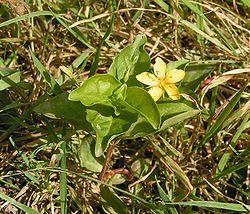| Yellow pimpernel | |
|---|---|
 | |
| Scientific classification | |
| Kingdom: | Plantae |
| Clade: | Tracheophytes |
| Clade: | Angiosperms |
| Clade: | Eudicots |
| Clade: | Asterids |
| Order: | Ericales |
| Family: | Primulaceae |
| Genus: | Lysimachia |
| Species: | L. nemorum |
| Binomial name | |
| Lysimachia nemorum | |
| Synonyms [1] | |
| |
Lysimachia nemorum, the yellow pimpernel, is a perennial flowering plant in the family Primulaceae.